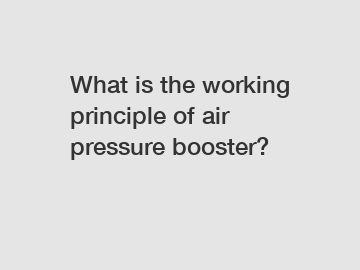What is the working principle of air pressure booster?
Welcome to our blog, where we explore the fascinating world of air pressure boosters. In industries where compressed air is vital for various applications, the role of air pressure boosters cannot be overstated. These ingenious devices possess an intricate working principle that enables them to efficiently amplify air pressure, leading to improved performance and productivity. Join us as we delve into the inner workings of air pressure boosters, uncovering their secrets and shedding light on their unparalleled capabilities.
Understanding Air Pressure Boosters:
Air pressure boosters, also known as air amplifiers, are mechanical systems designed to increase the pressure of compressed air beyond the capabilities of a conventional compressor. These specialized devices find extensive applications in industries such as automotive, manufacturing, aerospace, and more. By harnessing the principles of fluid dynamics, air pressure boosters provide a reliable and efficient solution for delivering high-pressure air when it's needed most.

The Working Principle - A Closer Look:
At its core, the working principle of an air pressure booster resembles that of a reciprocating engine. The booster comprises two main components: a primary piston and a secondary piston. Let's explore the step-by-step process involved in boosting the air pressure:
1. Compression Stage:
The primary piston, connected to the compressed air supply, begins its downward stroke. As it moves, it draws in ambient air through an intake valve, simultaneously compressing it and storing it in a cylinder chamber. This stage raises the pressure of the air, albeit within a limited range.
2. Transmission Stage:
As the primary piston reaches its lowest point, the transmission mechanism comes into play. This mechanism connects the primary piston to the secondary piston, transferring the air pressure from the primary piston to the secondary piston.
3. Amplification Stage:
The secondary piston, located in a separate cylinder chamber, receives the compressed air from the primary piston. As the primary piston begins its upward stroke, the transmission mechanism causes the secondary piston to reciprocate simultaneously. This synchronized movement amplifies the pressure of the incoming air, significantly surpassing the capabilities of the primary piston.
4. Discharge Stage:
After the air is boosted to the desired pressure, it is discharged through an outlet valve to be directed towards the application or stored in an air receiver for later use.
The Beauty Lies in the Details:
While the basic working principle of air pressure boosters may appear straightforward, it is the attention to detail that sets them apart. Several factors contribute to their high performance and efficiency:
1. Precision Engineering:
Air pressure boosters are crafted with meticulous precision to minimize energy losses, leakage, and friction. This precision ensures excellent efficiency and enables operators to benefit from impressive energy savings over time.
2. Intelligent Design:
Developed with years of experience and expertise, air pressure boosters are designed to withstand high pressure and maintain reliability even under demanding conditions. Their robust construction and thoughtful engineering make them ideal for a wide range of applications.
3. Versatility:
Air pressure boosters can be customized to suit individual requirements, allowing users to fine-tune their performance based on the specific industry needs. From boosting air pressure for pneumatic tools to enhancing the energy output in manufacturing plants, these systems serve various purposes.
Conclusion:
In conclusion, air pressure boosters exhibit a remarkable working principle, supported by intricate mechanisms and meticulous design. Their ability to amplify air pressure beyond the limitations of conventional compressors is testament to their efficacy in enhancing industrial productivity. Whether it's reducing cycle times in key processes or improving the overall efficiency of pneumatic systems, air pressure boosters play a vital role in numerous industries worldwide. As technology continues to advance, we can expect further development and innovation in this field, promising even more impressive performance and reliability.
Remember, when it comes to air pressure boosters, the possibilities are limitless, and the results are astounding.
If you are looking for more details, kindly visit air volume booster working principle, nitrogen pumps, burst test bench.
86
0
0


Comments
All Comments (0)